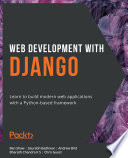Web Development with Django: Learn to Build Modern Web Applications with a Python-Based Framework by Ben Shaw, Saurabh Badhwar, Andrew Bird, Bharath Chandra K S, and Chris Guest Link to heading
Summary Link to heading
“Web Development with Django” is a comprehensive guide designed to equip readers with the knowledge and confidence to build real-world applications using the Django framework. The book adopts a hands-on approach, guiding readers through the creation of “Bookr,” a book review website, to illustrate Django’s core features and functionalities. :contentReference[oaicite:0]{index=0}
Chapters Link to heading
1. Introduction to Django Link to heading
Introduces Django and its role in web development. Covers the Model-View-Template (MVT) paradigm and demonstrates how to set up a Django project and application. :contentReference[oaicite:1]{index=1}
2. Models and Migrations Link to heading
Explains how to define data models and manage database schemas using Django’s ORM and migration system. Guides readers through creating models and performing database migrations.
3. URL Mapping, Views, and Templates Link to heading
Discusses routing web requests to appropriate views and rendering responses using templates. Explores function-based and class-based views, URL configurations, and template inheritance.
4. An Introduction to Django Admin Link to heading
Introduces Django’s built-in admin interface for managing application data. Covers creating superuser accounts, registering models, and customizing the admin interface.
5. Serving Static Files Link to heading
Explains how to serve static files such as CSS, JavaScript, and images. Covers static file configuration, usage of static template tags, and deployment considerations.
6. Forms Link to heading
Covers handling user input through forms. Discusses form creation, validation, and processing, as well as security considerations like Cross-Site Request Forgery (CSRF) protection.
7. Advanced Form Validation and Model Forms Link to heading
Delves into advanced form handling techniques, including custom validation, model forms, and formsets. Provides strategies for enhancing user input handling.
8. Media Serving and File Uploads Link to heading
Explores handling file uploads and serving media files. Covers configuring media storage, processing uploaded files, and serving them in development and production environments.
9. Sessions and Authentication Link to heading
Discusses user authentication and session management. Covers implementing login/logout functionality, managing user sessions, and securing user data.
10. Advanced Django Admin and Customizations Link to heading
Explores advanced customization of the Django admin interface. Covers adding custom views, modifying admin templates, and enhancing the admin site’s functionality.
11. Advanced Templating and Class-Based Views Link to heading
Delves into advanced templating techniques and the use of class-based views. Covers creating custom template filters and tags, and leveraging class-based views for efficient code organization.
12. Building a REST API Link to heading
Guides readers through building RESTful APIs using Django REST Framework. Covers serializers, viewsets, routers, and implementing API authentication.
13. Generating CSV, PDF, and Other Binary Files Link to heading
Explains generating and serving binary files such as CSVs and PDFs. Covers using libraries to create these files and integrating them into Django views.
14. Testing Your Django Applications Link to heading
Emphasizes the importance of testing and provides strategies for testing Django applications. Covers writing unit tests, integration tests, and using Django’s testing tools.
15. Django Third-Party Libraries Link to heading
Introduces popular third-party libraries that extend Django’s functionality. Covers installation, configuration, and integration of these libraries into projects.
16. Using a Frontend JavaScript Library with Django Link to heading
Explores integrating frontend JavaScript libraries, such as React, with Django. Covers setting up a frontend build process and connecting the frontend with Django’s backend.
Key Takeaways Link to heading
- Comprehensive Coverage: Provides an in-depth understanding of Django’s core features and advanced functionalities.
- Hands-On Approach: Utilizes a practical case study to demonstrate real-world application development.
- Advanced Topics: Covers advanced subjects like REST API development, testing, and frontend integration.
- Best Practices: Emphasizes best practices in web development, security, and code organization.
Review Link to heading
“Web Development with Django” is an invaluable resource for both beginners and experienced developers aiming to master Django. The book’s structured approach, practical examples, and comprehensive coverage make it a must-read for anyone looking to build robust web applications using Django.
